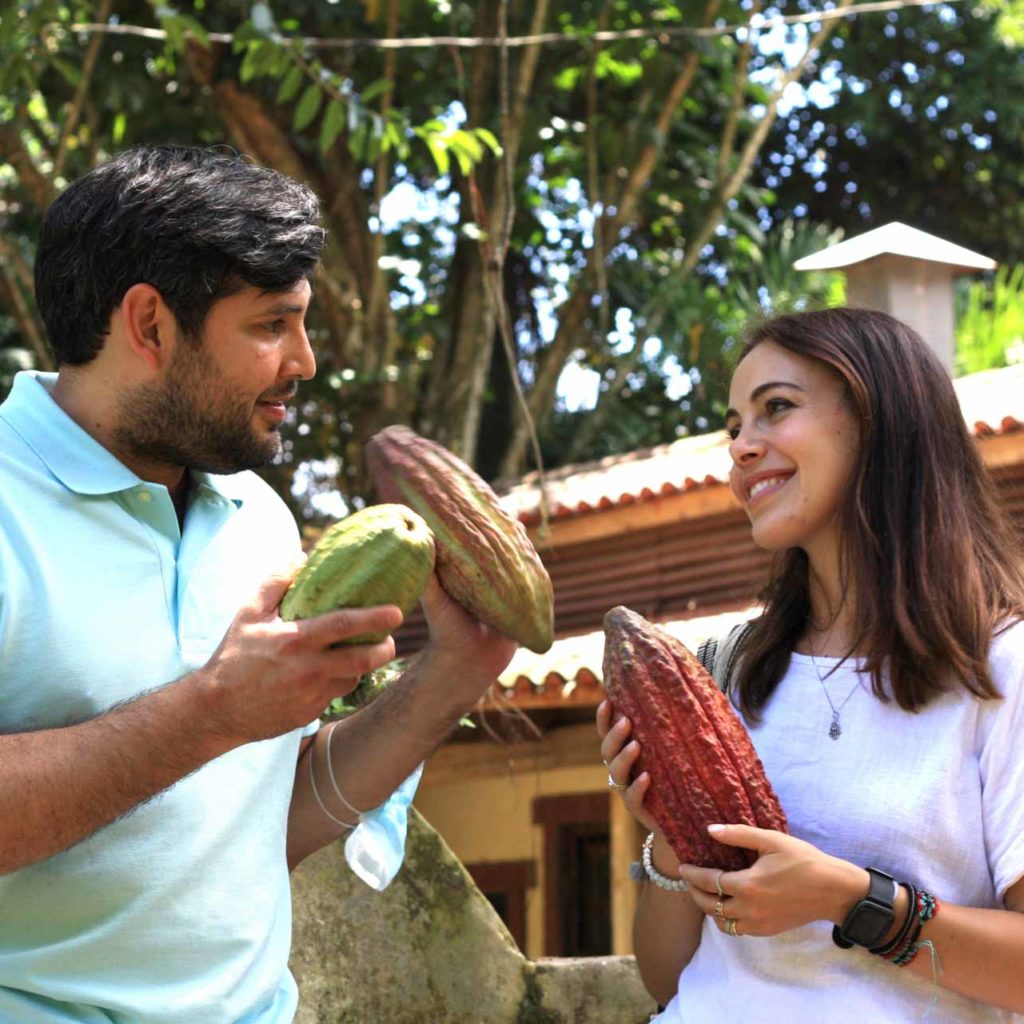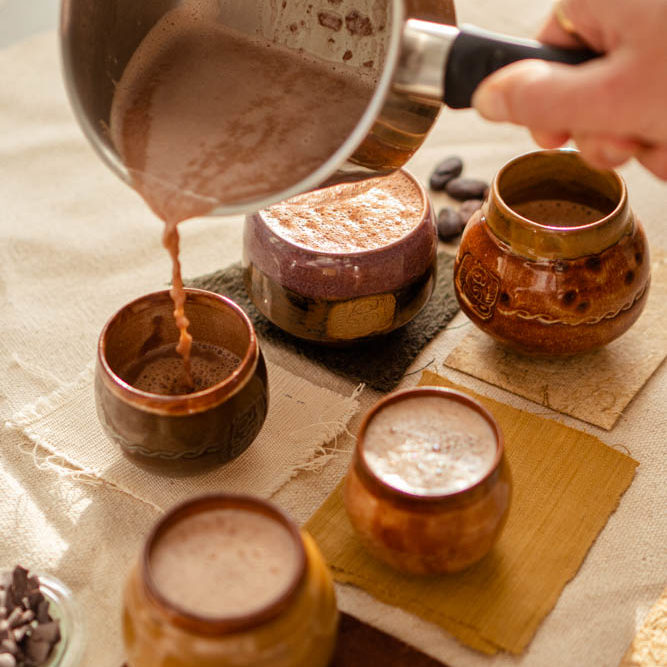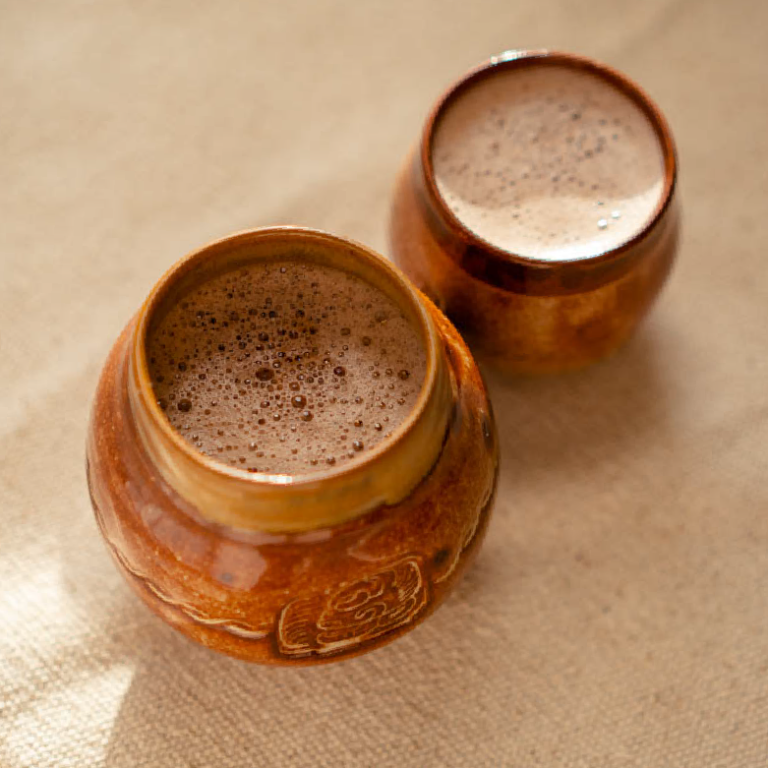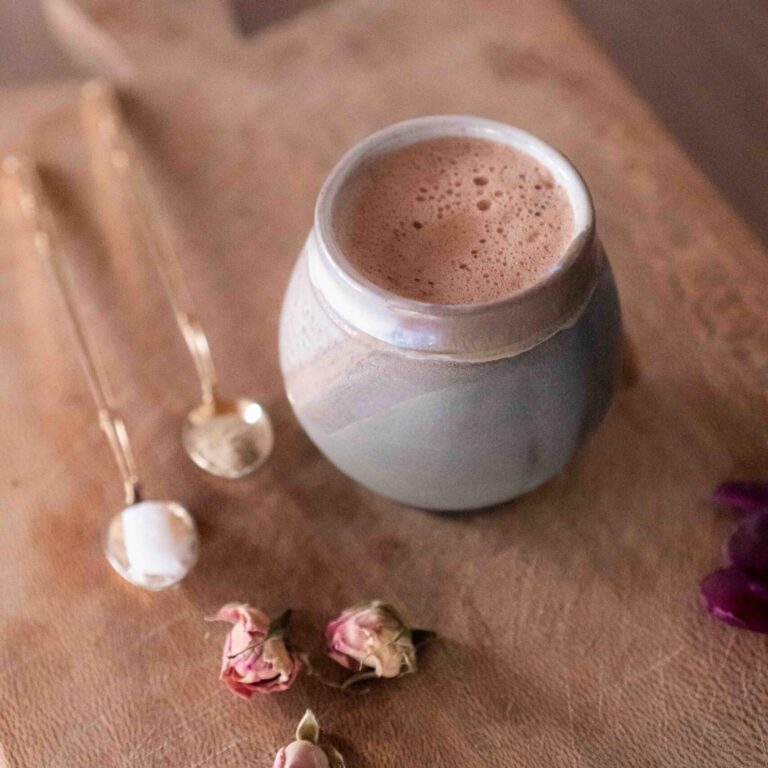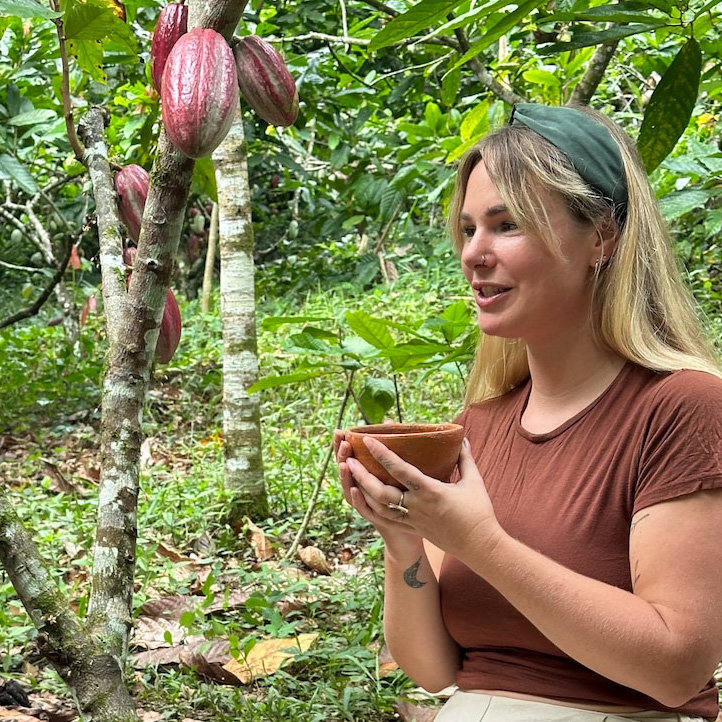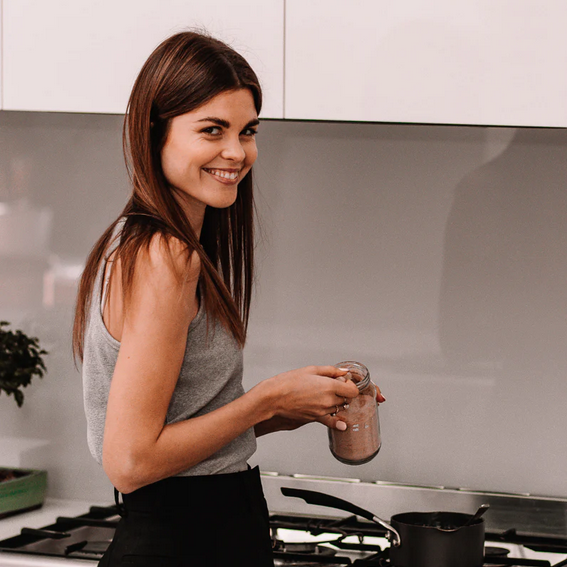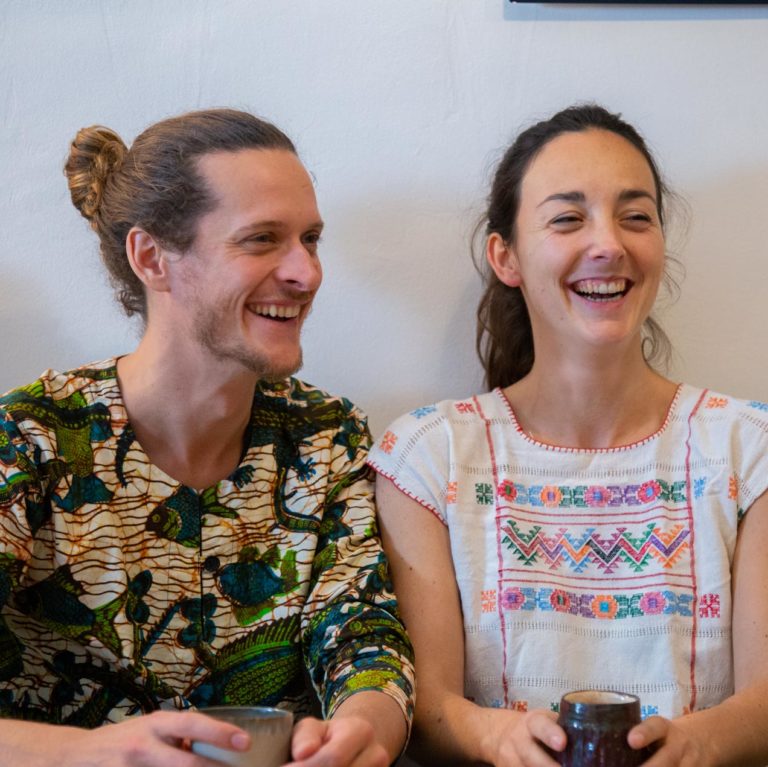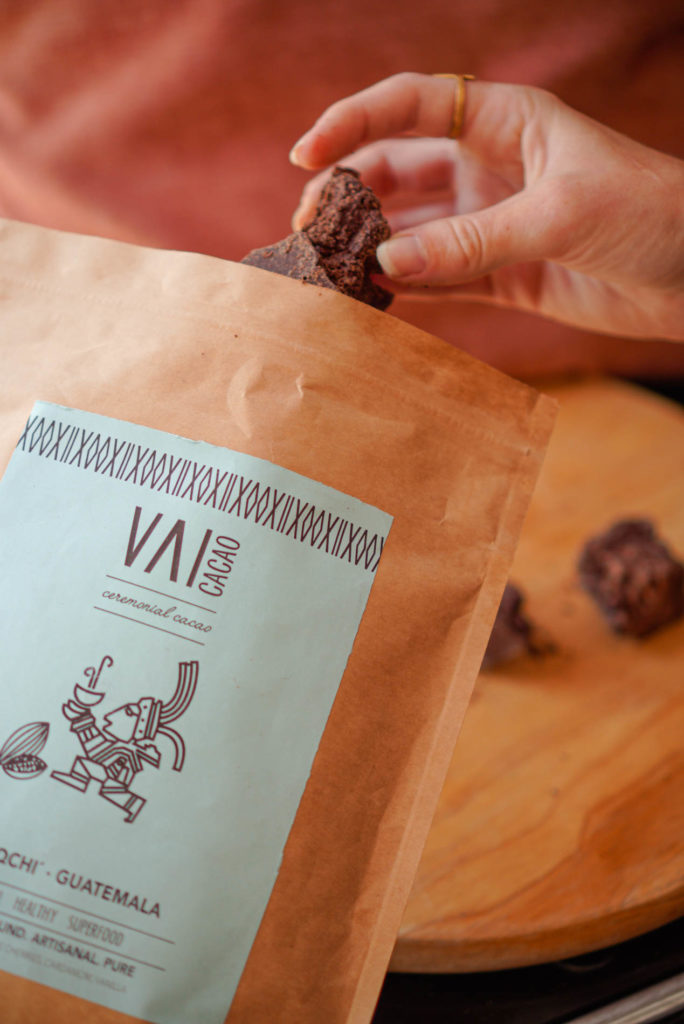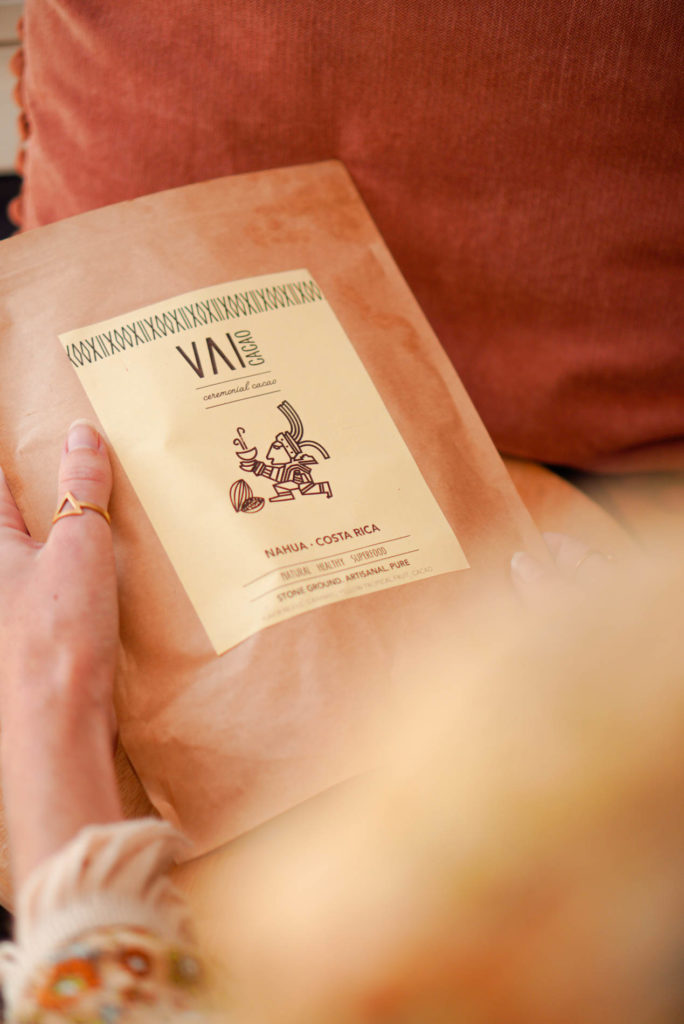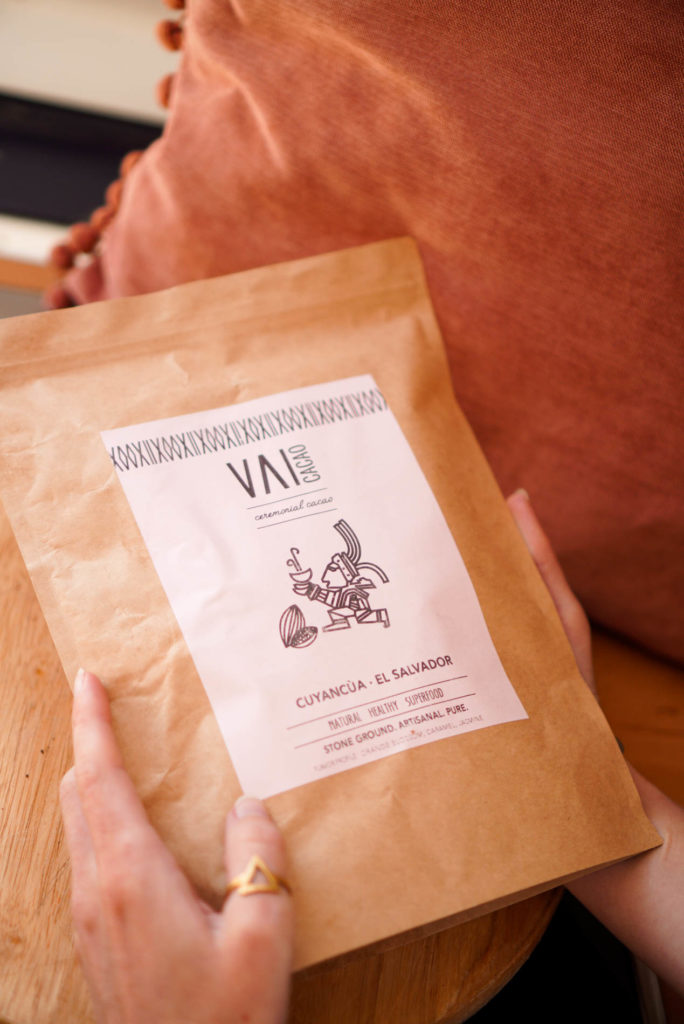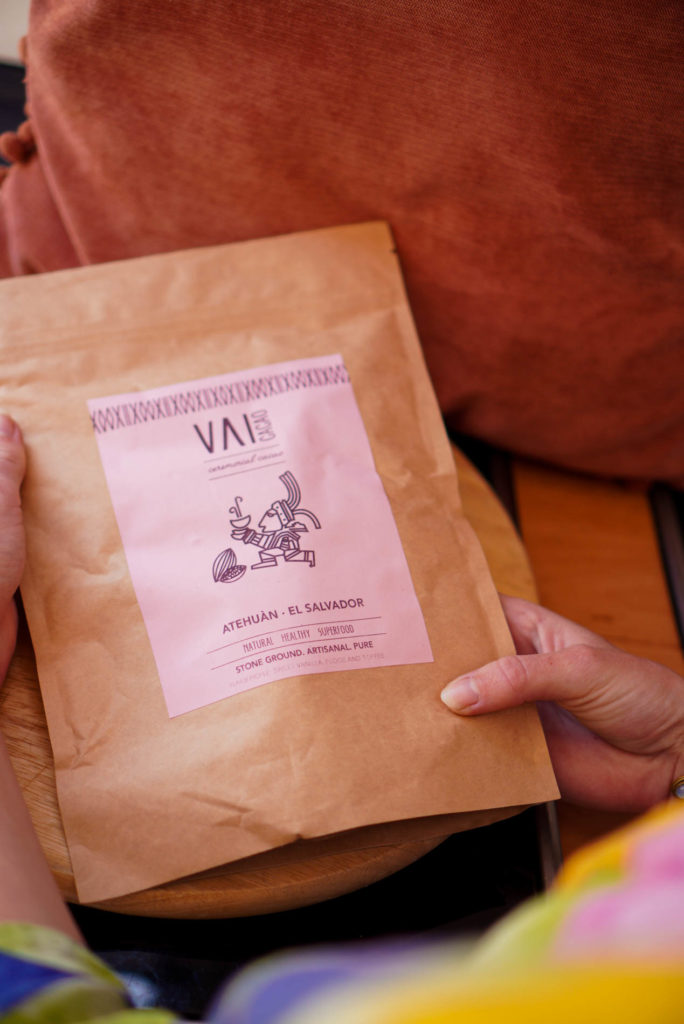— Elisa and Juan-Ra founded Vai Cacao in 2016 as a mean to promote and transform their own fine Salvadoran cacao into equally fine products.
" That’s one of the biggest differences that we, as a brand, want to do. We’re going to teach and share with other farmers how to do it and then buy their beans."
N.B. : This article contains an affiliate link and a 10% discount code. These advantages are here to compensate the time and work we put in our project. Yet, we’re dedicated to staying objective in our analyses.
Enjoy them if you want to try new cacaos while supporting us
03rd of July 2022
Being cacao entrepreneurs
What was your first encounter with pure cacao?
Elisa / It was in El Salvador. In Mesoamerica, it’s not difficult to find cacao that’s made in an artisanal way, which is destined to be consumed as a drink. Chocolate is less of a thing there. It’s easy to find some manually stone-grinded cacao, where beans are crushed over a traditional metate.
Juan-Ra / We were naturally exposed to it! Drinking it freshly made with a metate is a different experience though, because you can’t get to very fine particles, you actually leave pieces of nibs in your drink. It’s a completely different texture and a completely different drink that has something special.
So this is for pure cacao paste, if we look at it from a more « ceremonial » standpoint, it was still in El Salvador, during a solstice celebration.
What brought you to build your own brand?
Juan-Ra / We never started thinking we were going to make ceremonial cacao or chocolate, we were very fixed with the idea that we were going to reach consumer market with our cacaos. We started as cacao farmers who were always trying to sell their cacaos, but chocolate companies would come to us and say :
« We need more quantities to fill our container and you don’t produce that much so we can’t buy it from you. »
« We can have it cheaper from Africa, can you lower your cost ? »
So we said to ourselves, let’s break away with this and do things on our own. At first we collaborated with a local chocolate maker in El Salvador and he started doing the nibs for us. Then we noticed it wasn’t really the idea for us to import nibs in Sardinia but that it made more sense to import the beans and transform them freshly. Then slowly we started gathering the equipment to, little by little, create cacao paste and chocolate.
How do you navigate between fine chocolate and ceremonial cacao?
Juan-Ra / We see ourselves as cacao entrepreneurs, trying to promote cacao in its purest form.
We don’t label ourselves as chocolate makers, as our recipe is the most minimalist one and only has two ingredients compared to more regular recipes where makers would at least add cacao butter. But we do make chocolate aside of ceremonial cacao, as well as cacao nibs, so I’d say that our attention is really fixed on bringing cacao’s purity on the foreground.
How do you define ceremonial cacao?
Elisa / Oh my god, we have to do a brainstorming here (laughs).
Juan-Ra / In my opinion, ceremonial grade cacao is a cacao made with the intention to preserve the volatiles and compounds that can be lost in an industrial process.
Obviously, it has to be made with fine quality cacao beans. You can’t make ceremonial drinks with cacao beans that have fungus or mold or other things we see in bulk cacao.
So yeah, quality beans and setting the intention to preserve as much as you can of the cacao’s purity.
Elisa / For me, I like the part of rescueing Mesoamerican traditions. Promoting the original way of drinking it. Sustainability in the sense of transparency is also very important. Where it comes from, who is harvesting and treating it, who’s profiting from it…
Having information on the strains and soil as well.
Juan-Ra / One aspect that I’d like to add on is the quantity that you take. If you don’t have enough cacao, you can’t have a ceremonial drink. To feel its effects and energy, you have to intake a certain quantity. For instance 7g won’t likely bring you anything else than the nutritional benefits, whereas 15g and onwards will make you connect with what it has to bring.
Elisa / We’ve been doing things wrong with chocolate for a long time. Overgrowing, paying cents to farmers for their cacao, accepting really poor quality standards…
Via ceremonial cacao we have the opportunity to build another mindset. To use high quality beans and pay farmers what it’s worth. To share the awareness of how nourishing this food actually is.

Developing their farm and brand through direct-trade
How do you manage importing and trading directly with farmers ?
Elisa / We want to make cacao that is sustainable from the farmers’ side. We want to pay them more and more every year. We’re proud of the chain we built in El Salvador which allows for direct-trade since we really want to keep this growing.
Juan-Ra / We also buy from brokers sometimes, for some origins that are far away from El Salvador, like Costa Rica. Sometimes we cannot gather all the cacao in El Salvador to ship out, so obviously if Juan-Pablo from Nahua Cacao in Costa Rica tells us that he sent a fully loaded container in Europe and that we can buy it from there, we’re going to do that because it’s already here and we don’t have to invest our own ressources to import it.
Direct trade is really challenging because it’s not like if you pay today and the cacao will be there in a week. You have to put the money on the table and hope everything comes properly, without damage, extra import-costs induced by anti-fraud analysis, storage etc…
It’s a headache, and also the reason why we can’t spend the time we’d like doing other things, like telling our story. But on the other hand, it’s really satisfying to be able to support directly the farmers we deal with and it takes away the struggle when we receive their fresh cacao.
Are these the regular challenges of doing export on your own?
Juan-Ra / Well yes, this is the challenge we have to go through in order to get the cacao beans that we want. Otherwise we’d have to pick from what the brokers offer. We want our cacao so we have to get it ourselves (laughs).
This is the beauty of it because you’re able to offer a unique range of cacaos.
Juan-Ra / Yeah this is true. For instance our Atehuàn cacao is really existing because we had a conversation with the owners of the farms, we told them that they could diversify their crops by planting cacao. They did and now we buy it from them directly.
Initially we managed the post-harvest processes for them, as we have our own facility that was first destined to our local cooperative. But they grew so much that they’re now handling it in their own facility after having to learn how to do it.
Mathieu / It feels good to hear you share about the fact that the hard work that you’ve put in for yourselves actually grew on you neighbours, in a way that they are now able to put the skills you learned and shared into practice.
Elisa / When we started 6 years ago, we were somehow swimming in dark waters. But now the trees are growing so nicely, the harvests are fruitful, it does feel good yes.
In total you have 4 different Salvadoran cacaos in your range. How do you work with all of them?
Juan-Ra / Tlaloc is part of the coop we initially created, same thing with Atehuàn. At first they were going through our own post-harvest facility, but quickly they were able to handle their own process.
In our own farm, Cuyancùa, we’re now only processing our own beans.
Lenca is a bigger kind of farm, it’s a plantation and has been settled down for a long time. They’ve had the knowledge of handling their beans after the harvest from the beginning of our cooperation.
The situation in El Salvador is that, 15 years ago when we started planting cacao, we were the only ones advocating for it.
10 years ago, a lot of international organizations started to come and give away trees without really having the proper technical assistance for these trees to exist 10 years afterwards.
Lots of people were then encouraged without being properly supported and most of the trees that were planted then are now lost.
So what we’re doing is we’re trying to reactivte those who really kept up investing in it.
The ones that are now able to handle their trees are also fermenting and drying at their own place because it doesn‘t really make sense to do it otherwise if you have the quantity to do it. It’s an added value to the beans and it empowers farmers, allowing them to control the whole process.
That’s one of the biggest differences that we, as a brand, want to do. We’re going to teach and share with other farmers how to do it and then buy the stuff from them.

The influence of their roots & details on their family's cacao farm
- About Juan-Ra’s dad and his role in the Salvadoran cacao development -
Juan-Ra / He created a nice environment where he was practically transferring knowledge and information. Info that we learned from someone else because we invested in travelling to Colombia or Costa Rica, places where they were already producing cacao in a technified manner.
When we came back with the mentality of doing everything as a collective, obvisouly, sharing was power. It was a nice reciprocal thing to do and something that we carried into our brand.
- About their farm, finca Cuyancùa, and the cacao varieties there -
Juan-Ra & Elisa / It is located in Loz Izalcos, where cacao was historically grown by several ethnicities such as Mayas and Aztecs descendents. In fact, several strains of pure Criollo cacao were found on-site and have been DNA-tested to make sure of the tree’s rarity and historical importance of the site. Yet, the quantities of these pure strains are so small (because of cacao’s appetence for hybridization) and the beans are so fragile that only a micro-lot of isolated pure Criollo could be done and it would mean going through a lot of struggle and care for a very small result.
We don’t talk about it because for us it doesn’t make sense to market something you can’t give continuity to. Around those particular trees, very old and big cacao trees are growing and providing the beans we use.
Is there a cacao tradition in El Salvador?
Juan-Ra & Elisa / Yes there is, but it’s been lost. It’s a historical problem, between colonization and the actual dictatorship they have which created an ongoing persecution of the indigenous people. To this day, they’re still struggling with preserving their culture and traditions on all different levels.
One good part of working with ceremonial cacao is that it allows for sharing awareness around Mesoamerican cultures and traditions and might help on the long term to make it more present, therefore accepted, and to protect it.
You mention Trinitario acriollado as being the variety you grow, can you tell us more about it?
Juan-Ra / A few years ago, the International Cacao Organization (ICO) segmented the cacao varieties according to the strains’ origins and this allowed for saying that most of Mesoamerican cacao is Criollo cacao. But this is a very broad statement.
Criollo cacao is rare and scarce and is also highly subjected to hybridization. Just as on our farms, even though we performed DNA tests through a USDA program led in partnership with the University of the West Indies. It allowed us to validate its presence, yet the cacao we grow and use isn’t pure Criollo, at least the great majority of our harvests isn’t.
Our strains are hybdrids between those very rare Criollo and some more common Forastero or Trinitario trees. Criollo being present on-site, there is definitely an undeniable portion of it in our strains’ genetics. Trinitario acriollado is then a more specific way to name what we have, acknowleding cross-breeding and hybridization, as well as the presence of rare Criollo strains that definitely add up to the mix.
Insights
How did your own use of cacao evolved through the years?
Elisa / I drink cacao more or less 4 days a week, especially on the week-ends. It made me stop drinking coffee on a regular basis and now I only drink specialty coffee. I drink it with water, enhance it with mushrooms (chaga, reishi, shiitake), roots (ashwagandha, ginger) or spices.
I like it in the morning on an empty belly. And in terms of context, I love drinking it when I want to be creative, it helps me a lot in the process.
Juan-Ra / My relationship with cacao has evolved over the years. I come from a place where I’d only eat chocolate as a sweet, lots of it being white chocolate.
Then I started to learn about the nutritional benefits of cacao and it helped me move away from the vision I had of it as a candy. I then introduced cacao nibs in my diet and replaced sweets with it. Then we started making ceremonial cacao and the knowledge that transformed my habits came with it.
Your favorite recipe or way to prepare a cup of cacao?
Elisa / I’ve tried to replicate some traditional cacao beverages during the last years, but at the end my favorite is the one made with roses infused water (instead of just using hot water), 30 grams of chopped cacao, ashwagandha, mushrooms, cinnamon, damiana. I know it’s a weird blend, but it is so nourishing and calming. I do not add any sweetener, and If I do, I add prunes or dates into it. I also find very interesting combination with plant-based beverages, such as almond, cashew and oats.
Juan-Ra / More often I use cacao in my daily diet rather than use it for cacao circles or meditations. I like drinking about 15-20g of cacao with a plant-based milk, the biggest Medjool date I can find, and a small pinch of vanilla, all blended into a smooth and creamy hot drink for breakfast!
Your best memory linked to cacao?
Elisa / The first time I’ve seen the cacao farm, underneath the agroforestry system, at Cuyancùa, Juanra’s family farm. I remember clearly when I’ve touched the first time the tree and the pod, and I don’t know, some clear internal voice spoke to me like saying “ we must do something with your cacaos”. The memory is still vivid to me. I also remember the smell of the rainforest, the sounds of the birds, the fragrance of the Cedar and mahogany trees, and the soil.
Juan-Ra / I am lucky and grateful to have experienced lots of joy and beautiful moments with cacao since a young age and in different stages of the plant or its crops crafted into specialty products, so it is difficult to narrow it to down to one. The best older memory is the first time I remember entering a small remote area left “untouched” and as natural as possible in our family’s farm, where older cacao trees still grow underneath the tropical rainforest canopy, near a water sprout and has created a very special habitat. The tranquility of being among those ancient trees, and the water flowing in harmony with everything that was there was very special. Then I also have amazing new recent memories of many satisfactions of creating Vaicacao and the love and embrace from the holistic community and craft chocolate segments.
What are your plans for the future of the brand?
Juan-Ra & Elisa / Our project started with a clear intention since the beginning which we are still working to achieve:
To promote the cacaos from our family’s farm and other specialty cacaos from fellow farmers in El Salvador that were not able to reach international markets. Also, to bring awareness to the public about the traditions and ancient uses across Mesoamerica and the health and therapeutic benefits of cacao in its purest form. We want to contribute to improve the current and future rediscovery of the different benefits of cacao in this time and age with transparency, recognition and respect for everyone involved in our project, the respect for ancient cultures without picking and choosing to adopt certain aspects of their traditions, and make up new rituals with the only intention to monetize from it.
Our plans are to continue to support the cacao farmers by developing prosperous long term business relationship, so these cacao trees are kept alive, and they can sustain their livelihoods. All this while having fun crafting Vaicacao goodies for different segments who appreciate and enjoy the quality of our products and the different terroirs and “bliss effects” from these different specialty cacao beans from Central America.
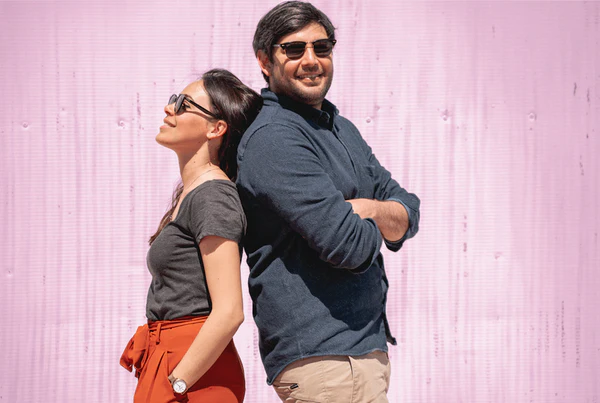
We hope you enjoyed this content! If you’d like to try Vai Cacao, feel free to use our 10% discount code: CACAOINSIGHTS.
INSIGHTS
RECIPES
PORTRAITS
Read more about Vai Cacao
©2024 Cacao Insights ☼ Made from the ♡

